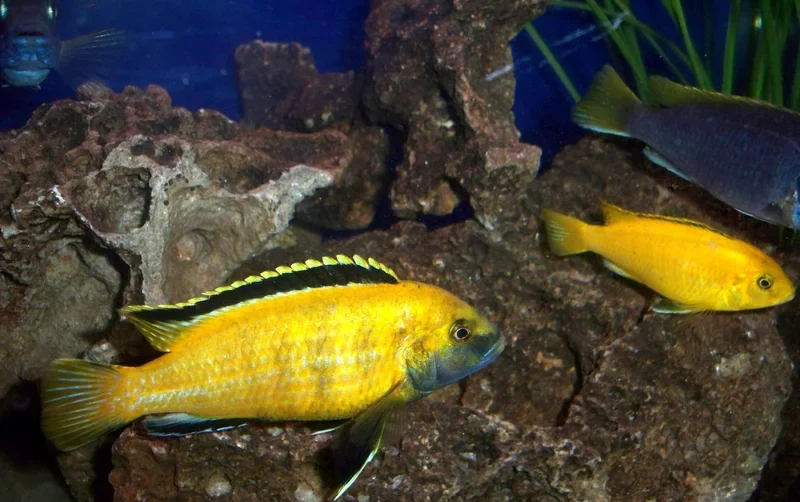
Size
Adults can only be up to 15 cm long (5.9 inches).
Physical Characteristics and Behavior
Yellow labs, also known as Labidochromis caeruleus, are a striking electric yellow color. It can be difficult to distinguish between the sexes. However, compared to the females, the males have fins with a darker tip. The location of Lake Malawi known as Lion’s Cove is where this sunny color first occurred.
Habitat
The following parameters are ideal for electric yellows: tank size: 55 gallon (210 litres); pH range: 7.8-8.9; temperature range: 23-26 degrees Celsius (73.4-78.8 degrees Fahrenheit); hardness range: 18-25 dGH (300-417 ppm).
In Captivity

- Care
These fish are good for beginners to keep because they are semi-aggressive. To ensure that your cichlids are happy and healthy, it’s crucial to set up a suitable tank and follow the right procedures. Here is a quick summary of the tank specifications:
- Tank Size
The tanks must hold at least 30 gallons of liquid. The ideal amount would be 50 gallons. However, the tank shouldn’t be overcrowded because the fish won’t develop to their ideal size there and will eventually become more aggressive.
- Tank Maintenance
The tank must have the right water density, a constant pH and water temperature, a certain level of water hardness, and frequent water changes. According to the yellow lab cichlids’ native habitat, the water’s density and level should be maintained. Lake Malawi’s water is alkaline because it contains a lot of minerals. The water’s pH must therefore fall between 7.2 and 8.8. The water should be kept at a constant temperature of between 22 and 28 degrees Celsius. The hardness must be kept between 10 and 20 dGH because the water is meant to be a little bit hardy.
In freshwater or slightly brackish freshwater, Yellow Lab Cichlids thrive. The main idea is the requirement for effective water filtration and transportation. Weekly water changes are advised to add 10–20% freshwater and new water.
- Feeding
When trained in an aquarium, the Yellow Lab Cichlid switches from its carnivorous diet in the wild to an omnivore one. It can easily consume all fresh, living foods as well as foods in flakes. They should consume an equal mix of plants and animals in their diet. These fish can be fed live natural protein sources like shrimp, mysids, and blood worms as well as prepared and frozen feeds including premium flake food, pellets, and dry foods.
Vitamins and supplements like food-based carotenoids should also be a regular component of their diet. These aid in maintaining their youthful appearance and wellness. Instead of one major feeding, it is advised to give them modest meals multiple times throughout the day. Additionally, this aids in maintaining optimum water quality.
- Tank Mates
Yellow Lab Cichlids are not community fish because they lack a sense of territoriality. Although they are calm, they are more tolerant of other Cichlids. They can live alone or in pairs within a group of cichlids.
You must be very careful around your tank mates. They get along well with non-aggressive and moderately aggressive fish, however highly predatory and aggressive fish can pose a hazard to your Yellow Lab Cichlids. Shrimp, crabs, snails, and other smaller fish are at risk from them. Other Mbuna fish and Malawi cichlid species like Yellow Tail Acei Cichlid, Blue Dolphin Cichlids, Rusty Cichlid, Perlmutt, Zebroids, etc. can make excellent companions.
Table





